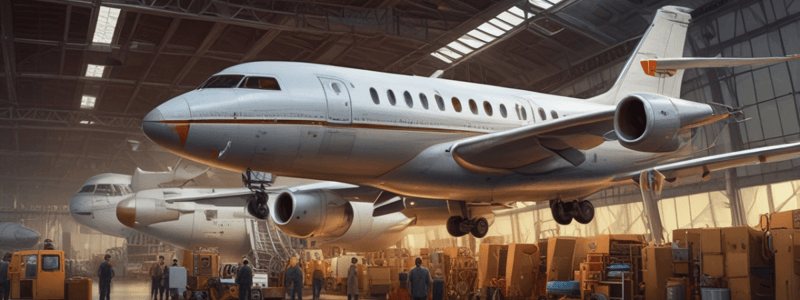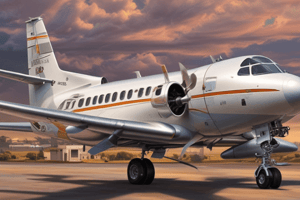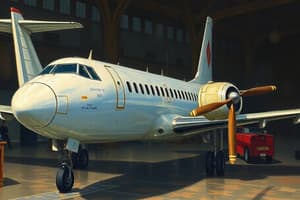Podcast
Questions and Answers
What is the primary purpose of establishing a compliance calendar?
What is the primary purpose of establishing a compliance calendar?
- To plan for aircraft upgrades
- To monitor and ensure time-sensitive maintenance tasks and inspections are performed on schedule (correct)
- To schedule routine maintenance tasks
- To track pilot flight hours
What is the benefit of using a checklist during pre-flight inspections and regular maintenance checks?
What is the benefit of using a checklist during pre-flight inspections and regular maintenance checks?
- It prevents overlooking of critical items during inspections (correct)
- It ensures that all necessary maintenance tasks are performed
- It reduces the workload of maintenance technicians
- It helps pilots to identify potential safety hazards
What is the key to formulating an effective compliance strategy in aviation?
What is the key to formulating an effective compliance strategy in aviation?
- Implementing a quality control process
- Integrating regulatory knowledge, meticulous planning, and commitment to airworthiness (correct)
- Reacting to regulatory changes as they occur
- Conducting regular audits
What is the purpose of engaging in a continuous improvement process?
What is the purpose of engaging in a continuous improvement process?
What is the benefit of staying informed about regulatory changes?
What is the benefit of staying informed about regulatory changes?
What is the primary focus of a compliance strategy in aviation?
What is the primary focus of a compliance strategy in aviation?
What is the role of feedback in the continuous improvement process?
What is the role of feedback in the continuous improvement process?
What is the purpose of developing a checklist based on the aircraft's Equipment List, ADs, and other mandatory requirements?
What is the purpose of developing a checklist based on the aircraft's Equipment List, ADs, and other mandatory requirements?
What is the outcome of establishing a compliance strategy that meets and exceeds FAA requirements?
What is the outcome of establishing a compliance strategy that meets and exceeds FAA requirements?
What is the key to ensuring that all necessary records and documentation are updated accordingly?
What is the key to ensuring that all necessary records and documentation are updated accordingly?
A compliance strategy in aviation can be formulated by only considering regulatory knowledge.
A compliance strategy in aviation can be formulated by only considering regulatory knowledge.
A checklist based on the aircraft's Equipment List, ADs, and other mandatory requirements is only used during pre-flight inspections.
A checklist based on the aircraft's Equipment List, ADs, and other mandatory requirements is only used during pre-flight inspections.
Feedback from pilots, technicians, and compliance officers is not necessary for refining the maintenance plan.
Feedback from pilots, technicians, and compliance officers is not necessary for refining the maintenance plan.
The purpose of a compliance calendar is to only monitor time-sensitive maintenance tasks.
The purpose of a compliance calendar is to only monitor time-sensitive maintenance tasks.
A compliance strategy in aviation focuses solely on meeting FAA requirements.
A compliance strategy in aviation focuses solely on meeting FAA requirements.
Regulatory knowledge is the only factor in formulating an effective compliance strategy in aviation.
Regulatory knowledge is the only factor in formulating an effective compliance strategy in aviation.
The continuous improvement process only involves feedback from pilots.
The continuous improvement process only involves feedback from pilots.
A compliance calendar is used to update records and documentation.
A compliance calendar is used to update records and documentation.
Staying informed about regulatory changes is optional for establishing a compliance strategy.
Staying informed about regulatory changes is optional for establishing a compliance strategy.
The primary focus of a compliance strategy in aviation is on efficiency.
The primary focus of a compliance strategy in aviation is on efficiency.
How can a compliance calendar ensure that all necessary records and documentation are updated accordingly?
How can a compliance calendar ensure that all necessary records and documentation are updated accordingly?
What is the primary benefit of using a checklist based on the aircraft's Equipment List, ADs, and other mandatory requirements during pre-flight inspections and regular maintenance checks?
What is the primary benefit of using a checklist based on the aircraft's Equipment List, ADs, and other mandatory requirements during pre-flight inspections and regular maintenance checks?
What is the value of engaging in a continuous improvement process in aviation maintenance?
What is the value of engaging in a continuous improvement process in aviation maintenance?
What is the ultimate goal of formulating a compliance strategy in aviation?
What is the ultimate goal of formulating a compliance strategy in aviation?
Why is regulatory knowledge essential for formulating an effective compliance strategy in aviation?
Why is regulatory knowledge essential for formulating an effective compliance strategy in aviation?
What role do pilots, technicians, and compliance officers play in refining the maintenance plan?
What role do pilots, technicians, and compliance officers play in refining the maintenance plan?
What is the relationship between a compliance strategy and airworthiness?
What is the relationship between a compliance strategy and airworthiness?
Why is staying informed about regulatory changes critical for establishing a compliance strategy?
Why is staying informed about regulatory changes critical for establishing a compliance strategy?
What is the key to successfully implementing a compliance strategy in aviation?
What is the key to successfully implementing a compliance strategy in aviation?
What is the ultimate outcome of a well-formulated compliance strategy in aviation?
What is the ultimate outcome of a well-formulated compliance strategy in aviation?
Flashcards are hidden until you start studying
Study Notes
Aircraft Maintenance Compliance
- Ensuring ongoing compliance with FAA regulations is crucial for aviation safety
- FAA regulations are established to ensure every flight is as safe as possible
- Aircraft maintenance requires constant check-ups, tweaks, and care, similar to an athlete maintaining peak condition
Importance of Record Keeping and Documentation Management
- Proper record keeping is essential for maintaining and monitoring compliance
- Every repair, inspection, and maintenance activity must be logged accurately
- Rigorous record-keeping helps prevent oversights and ensures the aircraft's history is accurately recorded
Strategies for Maintaining Compliance
- Regularly update and review maintenance plans to reflect changes in regulations and operating environments
- Implement a training program for maintenance personnel to stay updated on new regulations and industry best practices
- Establish a compliance calendar to monitor and ensure time-sensitive maintenance tasks and inspections are performed on schedule
- Develop a checklist to ensure all items are checked during pre-flight inspections and regular maintenance checks
Creating a Compliant Maintenance Plan
- A compliant maintenance plan should include a schedule of routine maintenance and inspections, procedures for unscheduled maintenance, and a clear outline of responsibilities and qualifications of maintenance personnel
- The plan should also include a system for record-keeping that documents all maintenance actions performed, parts replaced, and return to service authorization
Ensuring Ongoing Compliance
- Continuous compliance requires constant vigilance and a cyclical process of reviewing and updating the maintenance plan
- Engage in a continuous improvement process that includes feedback from pilots, technicians, and compliance officers to refine the maintenance plan and improve safety and efficiency
Module 4: Ensuring Ongoing Compliance with FAA Regulations
- Ensuring ongoing compliance with FAA regulations is crucial for aircraft maintenance and operations
- Compliance involves understanding and managing FAA documentation, including maintenance logs, inspection records, and airworthiness directives
- Maintaining compliance is critical for aircraft safety, crew and passenger safety, and the longevity and efficiency of aircraft operations
Best Practices for Maintaining and Monitoring Compliance
- Organized record keeping and documentation management is essential for compliance
- Create a compliant maintenance plan by reviewing aircraft maintenance records, consulting applicable Airworthiness Directives, and coordinating with the designated maintenance team
- Documenting maintenance actions, parts replaced, and return to service authorization is critical for legal proof of compliance
Importance of Compliance
- Non-compliance can lead to catastrophic failures and safety risks
- Compliance is an ethical commitment to safety and is essential for the entire structure of aviation safety
FAA Documentation Relevant to Maintenance Planning
- Title 14 of the Code of Federal Regulations (14 CFR), specifically part 43, part 65, and part 91, governs maintenance activities
- Advisory Circulars (ACs) provide guidance on interpreting regulations and applying best practices
Creating a Compliant Maintenance Plan
- A compliant maintenance plan should include a detailed schedule of routine maintenance and inspections, procedures for unscheduled maintenance, and a clear outline of maintenance personnel responsibilities and qualifications
- Record-keeping system should track the aircraft's total time in service and time in service since the last completed maintenance
Ensuring Ongoing Compliance with Airworthiness Standards
- Continuous compliance requires constant vigilance and a cyclical process of review and update
- Strategy should include regular review and update of the maintenance plan, training programs for maintenance personnel, a compliance calendar, and a checklist based on the aircraft's Equipment List, ADs, and other mandatory requirements
Aircraft Maintenance Compliance
- Accurate logging of repair, inspection, and maintenance activities is crucial for an aircraft's health and regulatory compliance.
Importance of Record-Keeping
- Rigorous record-keeping is vital for maintaining an aircraft's airworthiness.
- Updates and changes in FAA regulations must be regularly monitored and implemented.
Strategies for Compliance
- Regular training and education on FAA standards are critical for ground team members.
- Incorporating checks into routine procedures can ensure compliance.
- Digital tools and software can help streamline tracking and minimize human error.
Cultivating a Culture of Safety
- Fostering a culture of safety and continuous compliance within an organization is essential.
- Every team member must understand their role in maintaining airworthiness.
Case Study: Maintenance Compliance
- A compliant maintenance plan must consider historical data, manufacturer guidelines, and FAA directives.
- Reviewing aircraft maintenance records, consulting Airworthiness Directives, and coordinating with the maintenance team are essential steps.
- Documentation of all responses and actions is critical for proving compliance.
Consequences of Non-Compliance
- Non-compliance can lead to catastrophic failures and compromise the safety of crew and passengers.
- Maintenance compliance is an ethical commitment to safety, supporting the entire structure of aviation safety.
Formulating a Compliance Strategy
- Understanding FAA documentation, particularly Title 14 of the Code of Federal Regulations, is essential for creating a compliance strategy.
- Establishing a compliance calendar, developing checklists, and engaging in continuous improvement are key components of a robust compliance strategy.
Studying That Suits You
Use AI to generate personalized quizzes and flashcards to suit your learning preferences.




